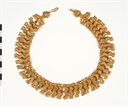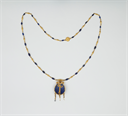Description
This earring is similar to, but not quite a pair with BZ.1928.16. Its ring is attached to the rest of the ensemble by a gold globule. Next, there is a pearl in a gold ring, held in place by a gold wire. This piece hooks onto a loop attached to a cabochon setting for an emerald, and from this hangs a small gold pear-shaped drop with a wire, holding a large pear-shaped sapphire.
This earring is part of the Piazza della Consolazione treasure, an extraordinary cache of late Roman jewelry said to have been uncovered in 1910 during restoration work on an old stable in the Piazza della Consolazione in Rome. Most of the objects from this cache are at Dumbarton Oaks, although some pieces also survive in the Metropolitan Museum of Art in New York, (inv. 1958, 58.12; and inv. 17.190.2053) and in private collections. Hordes like this are often thought to have been buried quickly when the owners, threatened by an invasion, concealed valuables from the potential conquerors. Since all of this jewelry has been dated to the early 5th century on stylistic grounds, its burial has been hypothetically associated with Alaric the Visigoth’s siege of Rome in 410, but this is pure speculation. The 1910 find itself is not reliably documented, leaving room for suspicion that the story of the unearthing of the treasure may have been developed by a dealer.
J. Hanson
Bibliography
Kalebdjian Frères, Exposition de bijoux antiques, exhibition catalogue, Kalebdjian Frères, December 20th, 1913-January 31st, 1914, (Paris, 1913), 32, no. 144.
Exposition internationale d'art Byzantin, exhibition catalogue, Musée des Arts Décoratifs, Palais du Louvre, 28 May-9 July, 1931, (Paris, 1931), 124, no. 372.
The Dumbarton Oaks Research Library and Collection of Harvard University, Handbook of the Collection (Washington, D.C., 1946), 62, no. 127.
The Dumbarton Oaks Collection, Harvard University (Washington, D.C., 1955), 75, no. 165.7.
M. C. Ross, Catalogue of the Byzantine and Early Mediaeval Antiquities in the Dumbarton Oaks Collection, vol. 2, Jewelry, Enamels, and Art of the Migration Period (Washington, D.C., 1965, 2nd ed. with addendum by S.A. Boyd and S. R. Zwirn, 2005), 1-4, no. 1.G, pl. 1.G, (Ross transposes BZ.1928.14-15 and BZ.1928.16-17).
Handbook of the Byzantine Collection (Washington, D.C., 1967), 43-44, no. 154.G.
A. Lipinsky, "Il Tesoro di Piazza della Consolazione," L'Urbe: revista romana di storia, arte, lettere, costumanze 36 (1973): 9-24, esp. 14-15, no. VIII, fig. 8.
A.-M. Manière-Lévêque, "L'évolution des bijoux "aristocratiques" féminins à travers les trésors proto-byzantins d'orfêverie," Revue archéologique (1997): 79-106, esp. 82-83, pl. 2.D, (Manière-Lévêque transposes BZ.1928.12a-b and BZ.1928.16-17).
I. Baldini Lippolis, L'oreficeria nell'impero di Costantinopoli tra IV e VII secolo, Bibliotheca archaeologica 7 (Bari, 1999), 34-35, 91, no. 2.II.4.a.5, (Baldini Lipporis, following Ross, transposes BZ.1928.14-15 and BZ.1928.16-17).
Exhibition History
Paris, Croix-Rouge Française, "Exposition d'Objets d'art du Moyen age et de la Renaissance…Ancien Hôtel de Sagan," 1913.
Paris, Musée des Arts Decoratifs, "Exposition d'art byzantin," 1931.
Cambridge, Fogg Museum, "A Selection of Ivories, Bronzes, Metalwork and Other Objects from the Dumbarton Oaks Collection," Nov. 15 - Dec. 31, 1945.
Acquisition History
Found in 1910 during restoration work in Piazza della Consolazione, Rome.
Purchased from Kalebdjian Freres, Paris, by Mildred and Robert Woods Bliss, 1928.
Collection of Mildred and Robert Woods Bliss, Washington, DC, 1928-1940.
Dumbarton Oaks Research Library and Collection, Byzantine Collection, Washington, DC













